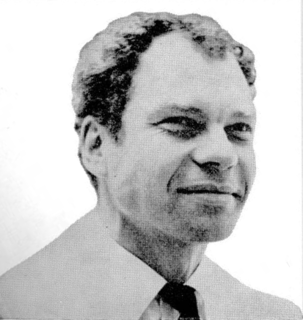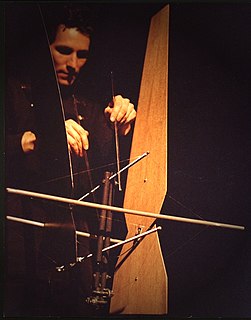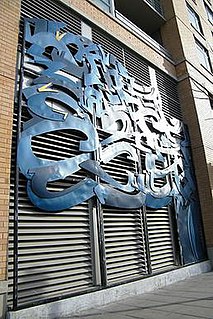
Digital art is an artistic work or practice that uses digital technology as part of the creative or presentation process. Since the 1960s, various names have been used to describe the process, including computer art and multimedia art. Digital art is itself placed under the larger umbrella term new media art.

Mercier Philip "Merce" Cunningham was an American dancer and choreographer who was at the forefront of American modern dance for more than 50 years. He was notable for frequent collaboration with artists of other disciplines, including musicians John Cage, David Tudor, Brian Eno, and graphic artists Robert Rauschenberg, Bruce Nauman, Andy Warhol, Roy Lichtenstein, Frank Stella, and Jasper Johns; and fashion designer Rei Kawakubo. Works that he produced with these artists had a profound impact on avant-garde art beyond the world of dance.
Judson Dance Theater was a collective of dancers, composers, and visual artists who performed at the Judson Memorial Church in Greenwich Village, Manhattan New York City between 1962 and 1964. The artists involved were avant garde experimentalists who rejected the confines of Modern dance practice and theory, inventing as they did the precepts of Postmodern dance.

Marco Brambilla is an Italian-born Canadian film director and video artist.
onedotzero is a contemporary digital arts organisation based in London, that aims to promote new work in moving image and motion arts, through public events, artist and content development, publishing projects, education, production, creative direction, and related consultancy services. It holds international events, including the onedotzero festival first held in 1997. onedotzero is supported by the Arts Council of England. It runs a free open submission scheme and receive around 2,000 entries from all over the world each year. The group curates, commissions, produces, and presents new moving image works that also include music, architecture, design, film, interaction design, computer gaming and live audio visual explorations.

Alan Berliner is an American independent filmmaker. The New York Times has described Berliner's work as "powerful, compelling and bittersweet... full of juicy conflict and contradiction, innovative in their cinematic technique, unpredictable in their structures... Alan Berliner illustrates the power of fine art to transform life."

Andrew Culver is a Canadian-American composer and software entrepreneur. Culver's works have included chamber and orchestral music, electronic and computer music, sound sculpture and music sculpture, film, lighting, text pieces, and installations. He performs concerts with sound sources of his own invention that are based on the tensegrity structural principle as elaborated by Buckminster Fuller, a lifelong influence.
Takehisa Kosugi was a Japanese composer, violinist and artist associated with the Fluxus movement.
Eiko Otake and Takashi Koma Otake, generally known as Eiko & Koma, are a Japanese performance duo. Since 1972, Eiko & Koma have worked as co-artistic directors, choreographers, and performers, creating a unique theater of movement out of stillness, shape, light, sound, and time. For most of their multi-disciplinary works, Eiko & Koma also create their own sets and costumes, and they are usually the sole performers in their work. Neither of them studied traditional Japanese dance or theater forms and prefer to choreograph and perform only their own works. They do not bill their work as Butoh though Eiko & Koma cite Kazuo Ohno as their main inspiration.
Deborah Hay is an experimental choreographer working in the field of postmodern dance. She is one of the founding members of the Judson Dance Theater.
Lois Greenfield is an American photographer best known for her unique approach to photographing the human form in motion. Born in New York City, she attended Hunter College Elementary School, the Fieldston School, and Brandeis University. Greenfield majored in Anthropology and expected to become an ethnographic filmmaker but instead, she became a photojournalist for local Boston newspapers. She traveled around the world on various assignments as a photojournalist but her career path changed in the mid-1970s when she was assigned to shoot a dress rehearsal for a dance concert. Greenfield has since specialized in photographing dancers in her photo studio as part of her exploration of the expressive potential of movement.

Kristin Jones and Andrew Ginzel are a contemporary American artist team. Both Jones and Ginzel pursue independent careers in the arts, but they are best known for their collaborative, large scale public art projects, installations and exhibitions in museums and galleries internationally.
Rose Bond is a Canadian-born media artist, animator and professor who currently lives and works in Portland, Oregon. She has been considered a scholar on the subject of animation and an experienced animator herself. Bond's animations and short films have been shown at film festivals including the Sundance Film Festival. Bond is also known for her architectural animation installations. She shown work at Exeter Castle in 2010 and created a prototype animation for the Smithsonian. Bond's hand-painted films are held in the film collection at the Museum of Modern Art.
Marilyn Wood is an American choreographer, intermedia artist, and dancer.
Daniel Arsham is an American artist. He lives and works in New York City.

Jonah Bokaer is an American choreographer and media artist. He works on live performances in the United States and elsewhere, including choreography, digital media, cross-disciplinary collaborations, and social enterprise.
Charles Atlas (disambiguation)

Inspiration is a public artwork by American artist Ethan Kerber, located at a commercial building at the intersection of 5th St NW & K St NW in the Mount Vernon Triangle neighborhood of Washington, D.C., United States. Inspiration was created through DC Commission on the Arts and Humanities.
Universal Everything is a digital art practice and design studio based in Sheffield, England. The studio was founded in 2004 by Matt Pyke, who is the creative director. Pyke studied botanical and technical illustration and then graphic design, before spending eight years at the Designers Republic (1996–2004).
Sarah Michelson is a British choreographer and dancer who lives and works in New York City, New York. Her work is characterized by demanding physicality and repetition, rigorous formal structures, and inventive lighting and sound design. She was one of two choreographers whose work was included in the 2012 Whitney Biennial, the first time dance was presented as part of the bi-annual exhibition. Her work has also been staged at The Walker Art Center, Jacob’s Pillow Dance Festival, The Kitchen, and the White Oak Dance Project. She received New York Dance and Performance awards for Group Experience (2002), Shadowmann Parts One and Two (2003), and Dogs (2008). She has served as associate director of The Center for Movement Research and associate curator of dance at The Kitchen. Currently choreographer in residence at Bard's Fisher Center, she is the recipient of their four-year fellowship to develop a commissioned work with Bard students and professional dancers.









